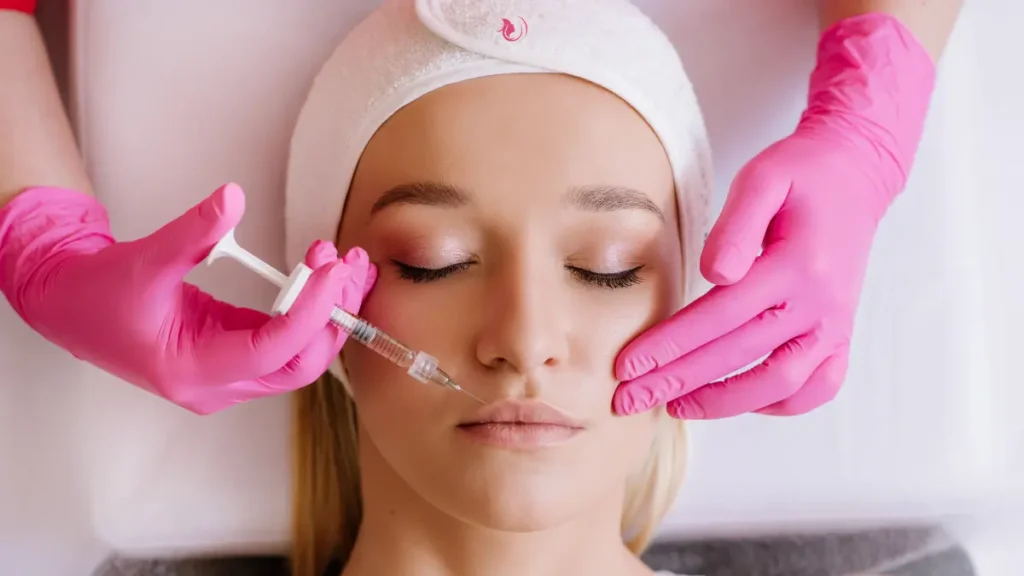Dermal fillers, darling, are quite the hot topic in the aesthetics world, and for good reason! They’re a bit like the fairy godmother of the beauty industry, working their magic to restore lost volume, smooth out wrinkles, and enhance facial contours. Here’s a breakdown in layman’s terms, so it’s easy to understand:
Dermal fillers are gel-like substances injected under the skin. They’re primarily made from hyaluronic acid, which is a naturally occurring substance in our skin. Think of hyaluronic acid as your skin’s natural hydration hero – it keeps things plump and dewy.
What Do They Do?
- Plumping up thin lips: Giving you that coveted fuller lip look.
- Enhancing shallow contours: Helping to soften facial creases and wrinkles.
- Softening facial creases and wrinkles: Particularly those pesky lines that run from the nose to the mouth.
- Improving the appearance of recessed scars: Making them less noticeable.
- Reconstructing contour deformities in the face: Sometimes used in patients with conditions like HIV that cause facial wasting.
- Decreasing or removing the shadow of the lower lids: Making you look more rested.
Types of Dermal Fillers
Many different dermal fillers are available, each with unique properties tailored to treat specific problems.
- Hyaluronic acid fillers are injected directly into the skin layers, helping to smooth out fine lines and deep wrinkles while also hydrating the skin from within.
- Calcium hydroxyapatite dermal fillers are thick gel-like substances that provide structure for facial contours to help add volume and shape to areas that may have sagged due to age or weight loss.
- Polylactic acid dermal fillers are used for a more subtle augmentative effect that gradually builds up over some time as it causes collagen stimulation in surrounding areas.
- Polymethylmethacrylate dermal fillers pair tiny microspheres with a gel-like substance to give an instant volumising effect while still naturally blending into the surrounding facial features.
Body parts where dermal fillers can be administered
The lips, cheeks, forehead, and lower face are common body parts to get dermal fillers. Additionally, dermal fillers can fix facial scars, contour jawlines and nose bridges, and plump up chin dimples or hollows in the temples. Dermal fillers can be a great way to enhance your natural beauty without going under the knife.
Who are good candidates for dermal fillers
Candidates who are seeking dermal fillers must be attended to by a trained professional to ensure the best results. Factors like age and the patient’s overall health may also be considered when considering dermal fillers as a potential solution for an individual. All dermal filler treatments must be performed safely and according to strict guidelines set by medical professionals to ensure optimal aesthetic results and safety for the client.
Cost of dermal fillers
Prices for dermal fillers can vary considerably depending on the practitioner’s qualifications and the type of dermal filler used – materials like hyaluronic acid or collagen can have different cost implications. But generally speaking, treatments will typically start from around £150 and range up to £400 per area, though they could be much higher depending on your treatment plan. It’s important to check out the credentials and experience of your chosen practitioner before deciding on a dermal filler provider.
Side effects of dermal fillers
While dermal fillers can result in a more youthful appearance, they also come with possible side effects such as bruising, swelling, redness, itching, and discomfort near the injection sites. In some cases, dermal fillers may also cause an inflammatory reaction resulting in firm lumps or nodules under the skin that may need to be treated. If you’re considering dermal filler treatments, you must speak with your doctor or aesthetic practitioner before treatment to understand the possible risks associated with this procedure.
How long do dermal fillers last
One of the most important factors when considering dermal fillers is understanding how long they last. Generally speaking, dermal fillers can last anywhere from 6 months to up to 2 years, depending on the product used and the individual’s metabolism. It is important to talk with your dermal filler provider about the dermal filler used and how long it is expected to last to ensure you understand how often treatments will be necessary for maintenance.
Now that you know more about dermal fillers, are you interested in trying them? If so, get in touch with SkinNV to book a consultation with them.



2 Comments
As someone who has undergone dermal filler treatments in the past, I found this blog post incredibly informative and well-written. It’s essential to understand the procedure before receiving it, and this post does an excellent job of explaining what to expect during and after the treatment. I appreciate the emphasis on the importance of choosing a qualified professional to administer the fillers, as it’s critical to ensure the procedure is done safely and effectively. It’s also good to know that dermal fillers can be used for more than just adding volume to the lips, such as smoothing fine lines and wrinkles. Overall, this post solidifies my understanding of dermal fillers and why they’ve become such a popular non-surgical cosmetic treatment.
‘m glad to hear that dermal fillers are made from natural substances like collagen and hyaluronic acid. It’s important to me to use products that are safe and won’t harm my body in the long run.